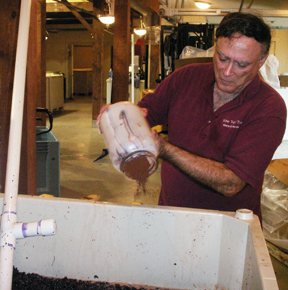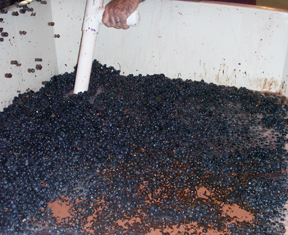More than Grapes Went into that Wine
by Terry Sullivan
It may be surprising to some to discover that winemakers may add a number of products in addition to grapes throughout the winemaking process. Although grapes do arrive at the winery with some natural yeast, winemakers often use commercial yeasts that can create a wine with a certain profile. There are hundreds of yeasts to select from and a particular yeast can be matched to the grape variety and what the winemaker wants for a final product. Other than yeasts, what other winemaking products are added to wine?
If one reads a wine bottle label notice the statement “Containes Sulfites”. Winemakers may add sulfites, for example potassium metabisulfite, during the winemaking process. It has been observed at some wineries that some mold on the fruit makes it into the fermentation bin. To remove every piece of fruit that has mold would be cost prohibitive. The potassium metabisulfite will prevent most microorganisms from growing. Any that survive will be killed by increasing levels of alcohol.
 Other winemaking products may be added to the fermentation bin. For example, the winemaker may add Lafase He Grand Cru, Color Pro and VR Supra. The Lafase He Grand Cru is an enzyme that helps to extract gentle tannins during fermentation. Color Pro is a pectinase that helps break down the cell walls of red grapes and gently extract phenols and tannins. Wines made with this pectinase tend to have increased tannins, reduced herbaceous character and improved clarity. VR Supra is a fermentation tannin that helps to keep indigenous tannins in the must rather than those tannins precipitating out. It will also help improve the mid-palate mouthfeel. Winemakers have many products that can be added to the fermenting must. Some may choose not to add any of these products while others readily have their favorites.
Other winemaking products may be added to the fermentation bin. For example, the winemaker may add Lafase He Grand Cru, Color Pro and VR Supra. The Lafase He Grand Cru is an enzyme that helps to extract gentle tannins during fermentation. Color Pro is a pectinase that helps break down the cell walls of red grapes and gently extract phenols and tannins. Wines made with this pectinase tend to have increased tannins, reduced herbaceous character and improved clarity. VR Supra is a fermentation tannin that helps to keep indigenous tannins in the must rather than those tannins precipitating out. It will also help improve the mid-palate mouthfeel. Winemakers have many products that can be added to the fermenting must. Some may choose not to add any of these products while others readily have their favorites.
If winemakers choose to have the wine undergo a secondary fermentation where malic acid is changed to lactic acid, they may add a lactic acid bacteria. Although malolactic fermentation may occur naturally, many winemakers do not risk this and add the bacteria that begin the process. Wines that have undergone this secondary fermentation tend to feel softer and richer tasting.
 Fermentation isn’t the only time winemaking products can be added to the wine. An array of products to choose from may be added during aging. Three products were added to the barrel of wine made by this author: Tan’Cor, Tan”Cor Grand Cru and Quertanin. The Tan’Cor was to improve the overall structure of the wine and to help protect the wine from oxidation during aging. The Tan’Cor Grand Cru also helped with the wine’s structure while enhancing a softer middle palate. The Quertanin helped with wood nuances without the toast and smoke character. These three winemaking products were added to the barrel to jumpstart the aging process.
Fermentation isn’t the only time winemaking products can be added to the wine. An array of products to choose from may be added during aging. Three products were added to the barrel of wine made by this author: Tan’Cor, Tan”Cor Grand Cru and Quertanin. The Tan’Cor was to improve the overall structure of the wine and to help protect the wine from oxidation during aging. The Tan’Cor Grand Cru also helped with the wine’s structure while enhancing a softer middle palate. The Quertanin helped with wood nuances without the toast and smoke character. These three winemaking products were added to the barrel to jumpstart the aging process.
Testing wines throughout the winemaking process can help the winemaker determine what may need to be added to the wine. If the pH of the wine is too high, the winemaker may add tartaric acid. Although the winemaker can follow a formula of how much tartaric acid to add, often the winemaker will taste the wine and determine the amount based on taste.
There are so many winemaking products that can be added to wine, one may wonder who makes these products. There are several companies throughout the world that produce winemaking products. Many of the products mentioned in this article were produced by Laffort, a Bordeaux, France based company established in 1895. During the 1800’s the Laffort family were pharmacists. At the time, if French winemakers noticed something wrong with their wines they would take there wines to a pharmacist for testing. Today Laffort makes a large array of winemaking products. Winemakers in 50 countries use Laffort products including yeasts, enzymes, nutrients, lactic acid bacteria, tannins and many others.
Some of the products added to the wine don’t make it to the bottle though. Through a series of racking, fining and filtering many products are left behind. By adding winemaking products, the winemaker can encourage the grapes to express themselves. They can create wines that are consistent from year to year. Winemaking products help the winemaker assist Mother Nature.
The next time you taste wine, don’t think of all the products that went into producing it, just decide if you like it or not.
